17 Breeds of Duck in Missouri (With Pictures)
Last Updated on
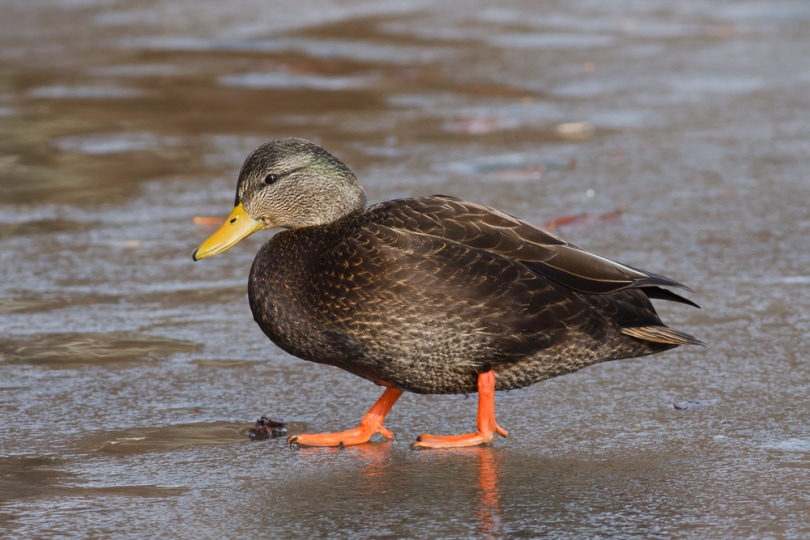
You may be impressed by the number of duck breeds you can find within the state of Missouri. Here, we’ve listed a total of 17 different breeds you can come across in the state, though you may find many more stopping by throughout their migratory patterns.
To more easily break this list down, we’ve separated the dabblers from the divers. Those that are a very rare sight in Missouri didn’t make the cut. So read along and find out which ducks are showing themselves in the Show-Me state.

The 17 Breeds of Duck in Missouri
Dabbling Ducks
Dabbling ducks are shallow-water ducks that forage along the surface of the water by tipping over and going headfirst into the water. Dabblers have smaller feet, and their legs are placed more forward on the body compared to the divers.
1. Mallard
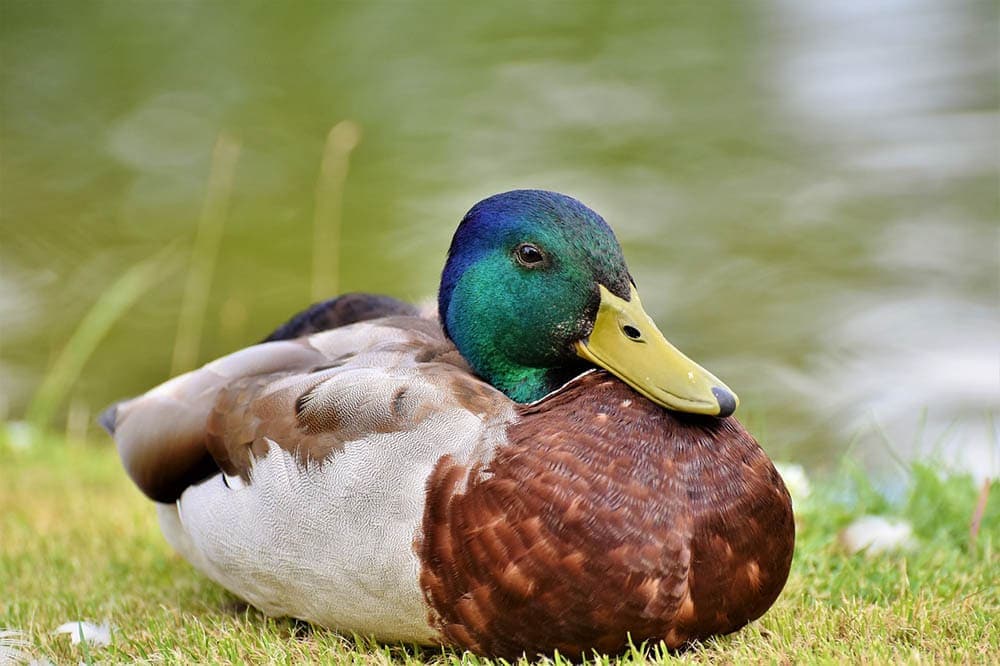
| Scientific Name: | Anas platyrhynchos |
| Wingspan: | 2.7 – 3.2 feet |
| Length: | 20-26 inches |
Mallards are the most prevalent breed of duck in the state of Missouri and one of the most abundant ducks throughout the entire world. They are found year-round within the state, though some don’t keep permanent residency and may migrate in during the winter. They are an adaptable breed that is found in a variety of wetland habitats.
Male Mallards feature the unmistakable green head and are probably the most popular duck known to humans. They are one of the most social breeds when it comes to human interaction. For the most part, Mallards won’t shy away from human handouts. The Mallard is the ancestor to most breeds of domesticated duck.
2. American Wigeon
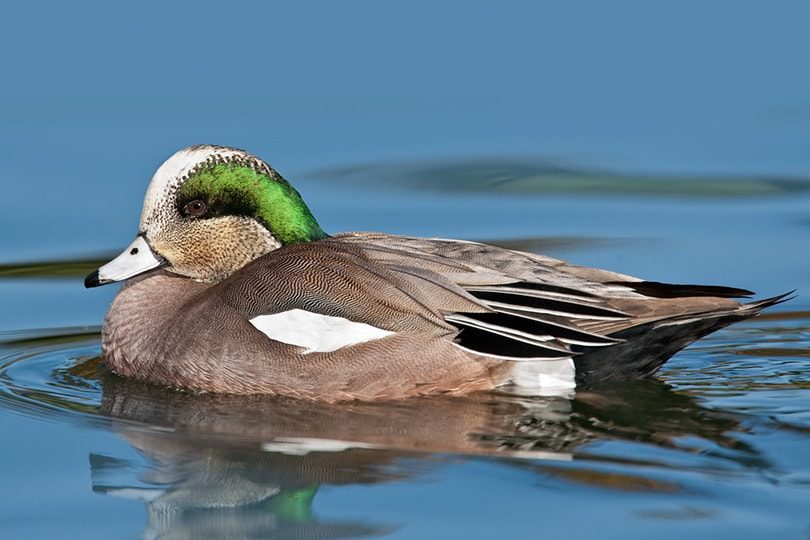
| Scientific Name: | Mareca americana |
| Wingspan: | 30-36 inches |
| Length: | 17–23 inches |
The American Wigeon is found in the northern half of Missouri during their migratory period and tends to spend winter in the southern portion of the state. These ducks are compact with round heads and a stubby bill. American Wigeons are shy and tend to stick to more quiet areas away from the hustle and bustle of humans.
Unlike most duck breeds, they are typically found foraging fields for vegetation. They have shorter bills that are well suited for vegetation, and they do consume more plant life than your average duck. Outside of fields, you may find them in rural areas near quiet lakes or marshes.
3. Blue-Winged Teal

| Scientific Name: | Anas discors |
| Wingspan: | 22-25 inches |
| Length: | 14-16 inches |
Blue-winged Teal are one of the most common duck breeds in North America, second only to the Mallard. They are popular among hunters, though regulated to ensure their numbers stay healthy. They can be found in the northern parts of Missouri during the breeding season and the southern half during their migratory period.
They are early migrants and are typically further south than Missouri by the time waterfowl season begins. This species is small in size and sports a distinct blue shoulder patch that is visible during flight, hence its name.
4. Gadwall
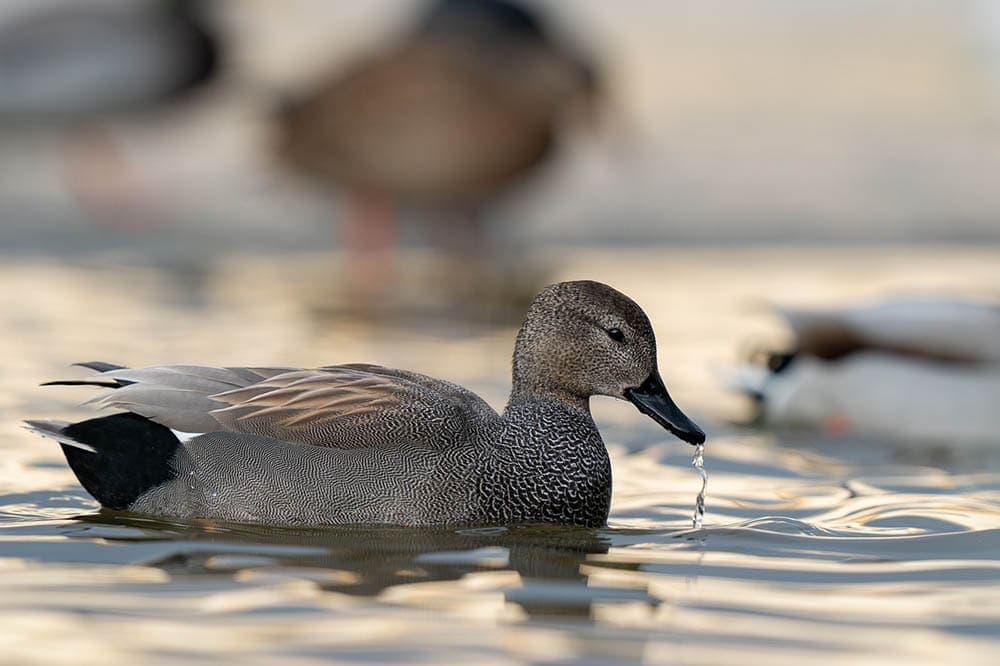
| Scientific Name: | Mareca strepera |
| Wingspan: | 31-35 inches |
| Length: | 18–22 inches |
Gadwalls won’t be the most easily observed duck breeds in Missouri. They may pass through during their migratory period and are sometimes found in the southernmost portion of the state during the winter, though they are still uncommon. Like the American Wigeon, they feed mostly on vegetation, but they are seldom seen on land foraging.
The Gadwall forages by swimming on the surface and by dabbling its head underwater, though it has been known to dive on occasion. Though they are widespread throughout North America, they are more common west of the Mississippi. They gravitate toward the prairie regions and western intermountain valleys away from forests where land is more open.
5. Northern Pintail
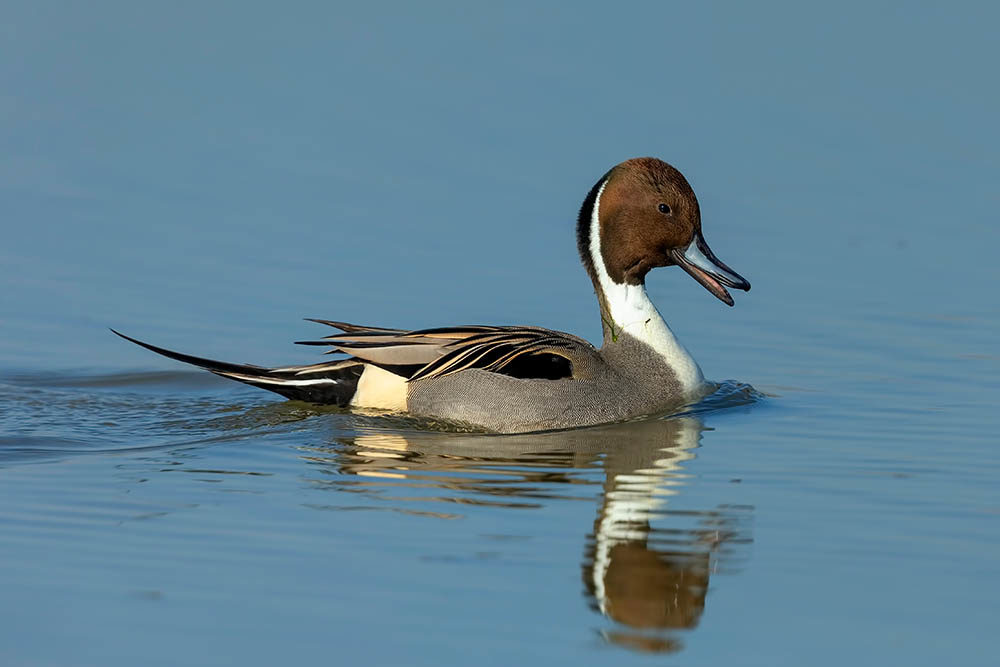
| Scientific Name: | Anas acuta |
| Wingspan: | Up to 34 inches |
| Length: | 20-30 inches |
The Northern Pintail is a widespread and abundant breed throughout North America but tends to prefer open habitats like prairies and vast farmland. They aren’t one of the most commonly observed breeds of duck in Missouri due to their habitat preference, though they will migrate through the state during the spring and fall.
The Northern Pintail gets its name from their long, thin tapered tail. They have a slim and elegant look with noticeably long necks. They are a more elusive breed that tends to be very wary of their surroundings.
6. Green-Winged Teal

| Scientific Name: | Anas carolinensis |
| Wingspan: | 20-23 inches |
| Length: | 12-15 inches |
The Green-Winged Teal is the smallest dabbling duck in North America. They are a common migrant throughout Missouri and a winter resident in the southern portion of the state. These little ducks are most often observed alongside other species. They are the second most hunted duck in the country.
They have a variable diet that consists mostly of plant material. They are frequently found in marshes, rivers, and bays. During summer they stick to open country with near freshwater sources but make their way to coastal estuaries and tidal zones during the winter.
7. Northern Shoveler

| Scientific Name: | Spatula clypeata |
| Wingspan: | 27-33 inches |
| Length: | 17-20 inches |
As with most other migratory ducks, the Northern Shoveler makes its way through Missouri during the spring and fall migration period. This breeds nests near the water in areas with thicker vegetation. This is a very common and widespread breed of duck throughout North America.
The Northern Shoveler is heavier bodied with thick, large, shovel-like bills. They tend to gather in large groups and are highly adaptable to a variety of habitats. They are often seen swimming across the surface of the water with their bills submerged in front.
8. Wood Duck
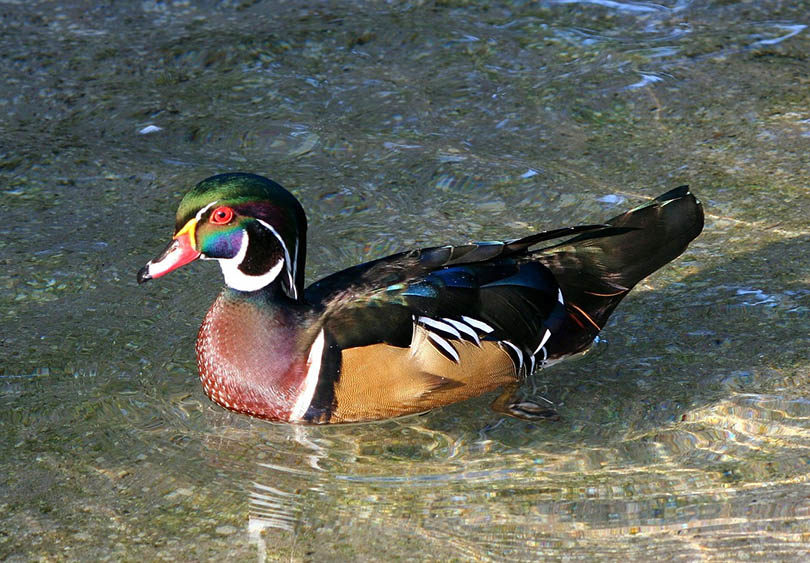
| Scientific Name: | Aix sponsa |
| Wingspan: | 28-39 inches |
| Length: | 19-21 inches |
Wood ducks are a very unique and recognizable breed of duck that is found in Missouri year-round in the southernmost portion of the state and during the breeding season throughout the rest of the state. They neared extinction in the early 20th century but made a beautiful comeback with a range that still seems to be extending.
Their coloration and plumage are like no other breed. They favor deciduous forests and are commonly seen near woodland ponds and rivers. Their diet consists of mostly seeds but they also feed on vegetation and the occasional insect or crustacean.
9. American Black Duck
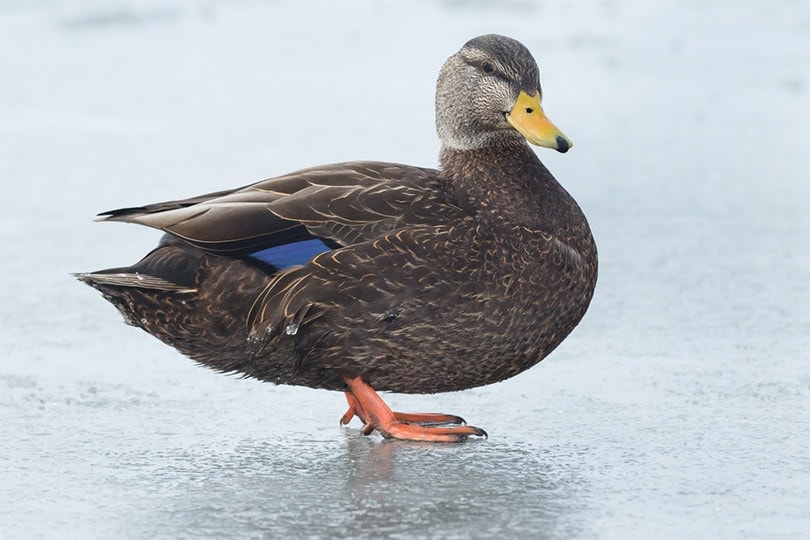
| Scientific Name: | Anas rubripes |
| Wingspan: | 2.9 – 3.1 feet |
| Length: | 19-25 inches |
Found in Missouri’s shallow wetlands, the American Black duck is a breed in which the males and females are almost indistinguishable. These ducks are most common in wintertime in the eastern portion of Missouri but can also be found throughout the entire state at this time, though they are less common.
American Black Ducks aren’t found further west than Missouri, they stick to the eastern United States and Canada. They thrive in a variety of wetland habitats and tend to interbreed with Mallards, causing some confusion with their population numbers within their range.
Diving Ducks
Diving ducks are categorized as a type of duck that feeds by diving beneath the water’s surface. Divers tend to have large feet with shorter legs that are further back on the body.
10. Bufflehead
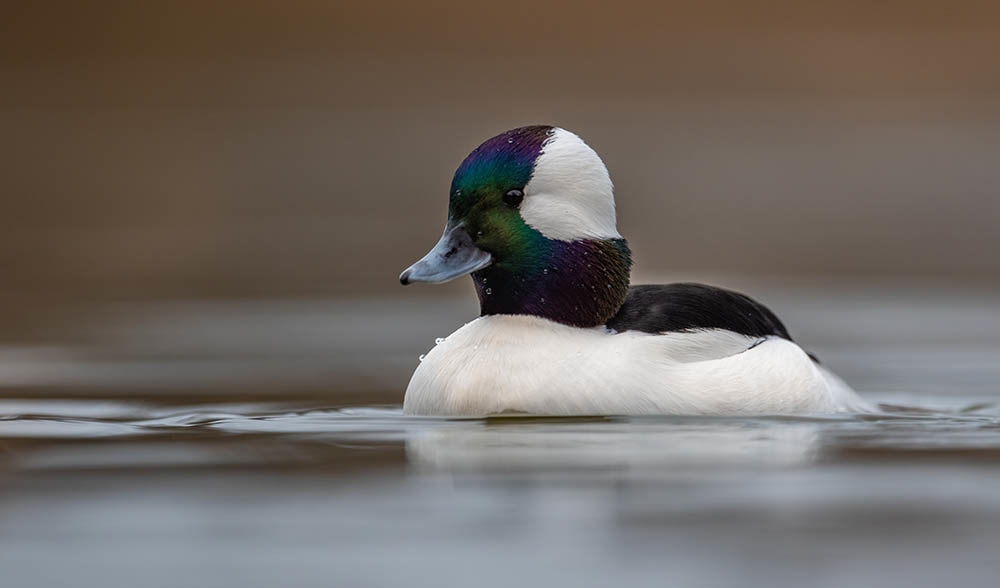
| Scientific Name: | Bucephala albeola |
| Wingspan: | 22 inches |
| Length: | 13-16 inches |
The Bufflehead is a small and compact duck with a large, round head. Their unique appearance helps them stand out from the crowd. Buffleheads can be found in Missouri during their migratory patterns and can be found statewide during the winter, though they are much more common in the southern portion.
Buffleheads feed primarily on aquatic insects in freshwater habitats and crustaceans when they are near the ocean. Unlike other divers, they can take off quickly without getting much of a head start. They tend to nest around smaller lakes and ponds.
11. Canvasback
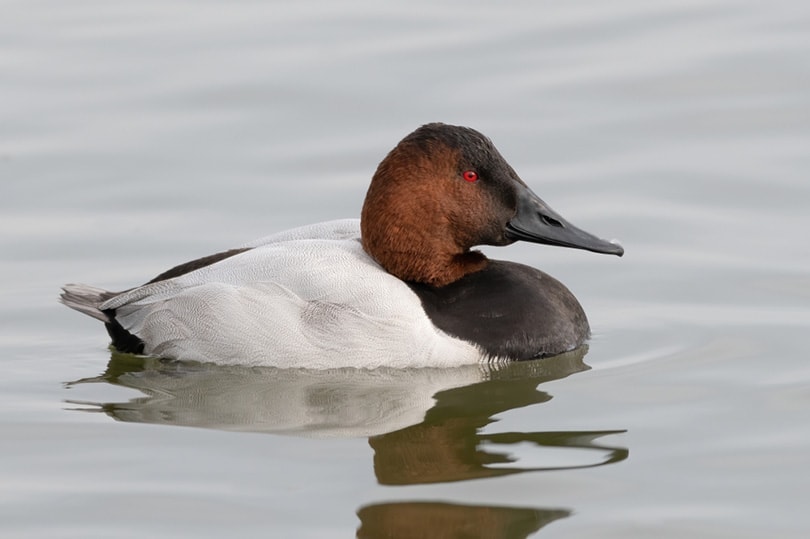
| Scientific Name: | Aythya valisineria |
| Wingspan: | 31-35 inches |
| Length: | 19–22 inches |
The Canvasback is found statewide throughout Missouri during the winter months, though they are most common near the Mississippi River. They feed on mostly plant material and tend to dive in more shallow water. This breed is rarely ever observed on dry land.
They migrate in the fall and early in spring and flocks are seen flying high, often in the V-formation. Their numbers have been declining over the years due to a decline in nesting habitat. To take off from the water, they must first run along the surface.
12. Common Goldeneye

| Scientific Name: | Bucephala clangula |
| Wingspan: | 30-33 inches |
| Length: | 16 – 20 inches |
Common Goldeneye is found statewide throughout Missouri during the winter and is a very common migrant to the state. They are avid swimmers that are common to the open water in rivers and lakes. They are hardly ever observed on land.
They get their name from their striking yellow eye coloration. The males have much more vibrant yellow eyes, while the females are a paler yellow. They forage under the water for crayfish, crabs, shrimp, and amphipods but do have a varied diet depending on the season and will feast on insects during summer.
13. Common Merganser
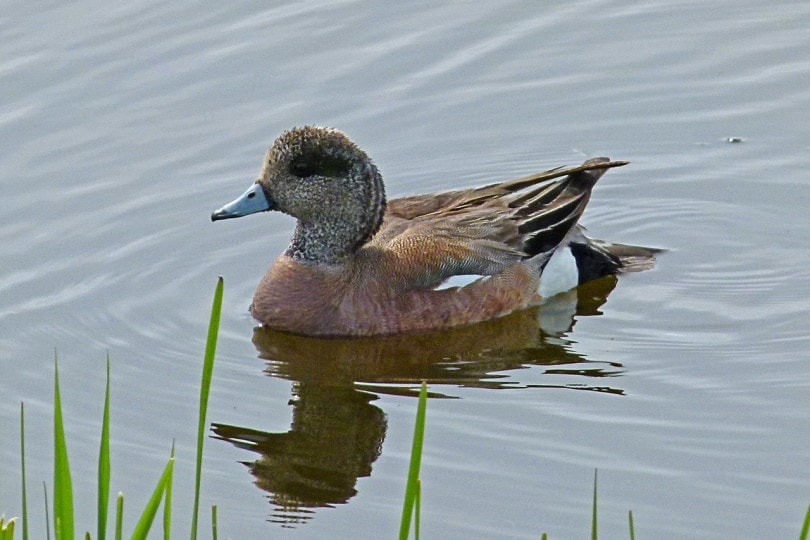
| Scientific Name: | Mergus merganser |
| Wingspan: | 30-37 inches |
| Length: | 1.7 – 2.3 feet |
The Common Merganser is seen in Missouri during the spring, fall, and wintertime. They eat a wide variety of fish as well as mussels, salamanders, and shrimp. These ducks are often found on lakes and rivers in heavily wooded areas.
Common Mergansers have a stable population in North America but have been noted for an increasing number in Europe. In England, they are referred to as the Goosander and have become very common along waterfronts in the city. In Missouri, you are most likely to see them in rivers or lakes statewide.
14. Hooded Merganser
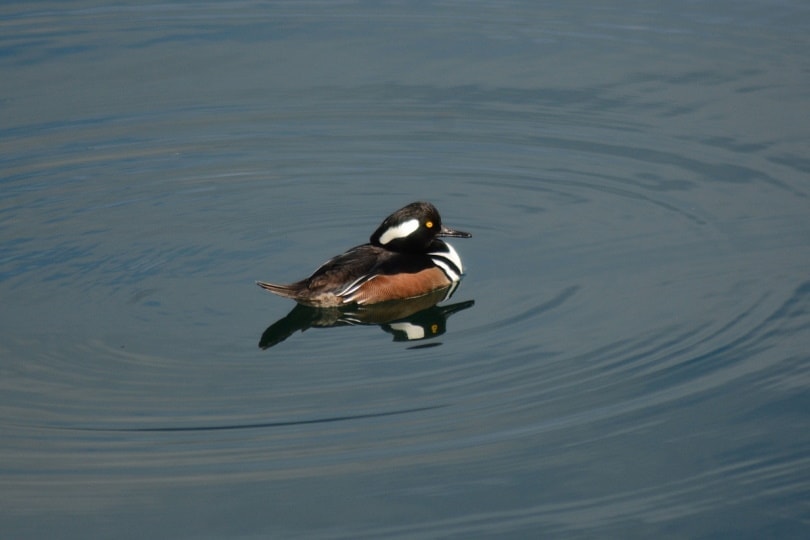
| Scientific Name: | Lophodytes cucullatus |
| Wingspan: | 23-26 inches |
| Length: | 13-19 inches |
The Hooded Merganser is a seasoned fish eater, and Mergansers are North America’s only duck breed that does so. They will also feed on other aquatic life, though the babies do start on insects. They have an excellent underwater vision and use it to forage under the water while being propelled by their feet.
They can be found statewide throughout most of Missouri all year round, except for the far northwestern region where they come into the area for the breeding season. Hooded Mergansers gravitate toward the forest-laden countryside near creeks, rivers, lakes, and ponds.
15. Lesser Scaup

| Scientific Name: | Aythya affinis |
| Wingspan: | 27–31 inches |
| Length: | 15-18 inches |
The Lesser Scaup is among the most abundant diving ducks within the United States. The breed is a common migrant seen statewide in Missouri. They spend their winters on lakes, reservoirs, and rivers within the state.
Though they still have a healthy population, their numbers have been declining over the past several decades due to causes that are not yet known. They sometimes frequent the same areas as the Greater Scaup but tend to stay separate. The Greater Scaup is a much rarer sight in Missouri.
16. Ring-necked Duck

| Scientific Name: | Aythya collaris |
| Wingspan: | 23-25 inches |
| Length: | 15-18 inches |
Ring-necked ducks frequent Missouri where they are found statewide during the migratory patterns in spring and fall. They are found all over North America and prefer wooded lakes and ponds and will also gravitate toward rivers and bays during the wintertime.
Despite being named the ring-necked duck, the ring is hardly ever visible. Unlike most other diving ducks, they can quickly rise from the water and take flight. They mostly feed on aquatic plants and insects, but their diet is varied depending on the season.
17. Ruddy Duck

| Scientific Name: | Oxyura jamaicensis |
| Wingspan: | 22-25 inches |
| Length: | 14-17 inches |
The Ruddy duck is a common migratory visitor to Missouri, making its way to the state during the wintertime. They are more common in the south than in the north. They are small ducks with a tail that sticks up. They are excellent swimmers that will dive to escape predators rather than fly.
During the summer, Ruddy Ducks will nest in dense vegetation but during their non-breeding season, they will spend their time on open water. These ducks feed on aquatic invertebrates and some plant material.

Conclusion
Not only does Missouri have some permanent resident ducks, but it also has a large number of migratory visitors. While there are more than 17 breeds of duck that migrate through the state, those on the list are the most common breeds you’ll see within state lines.
Featured Image Credit: Elliotte Rusty Harold, Shutterstock
Table of Contents
About the Author Robert Sparks
Robert’s obsession with all things optical started early in life, when his optician father would bring home prototypes for Robert to play with. Nowadays, Robert is dedicated to helping others find the right optics for their needs. His hobbies include astronomy, astrophysics, and model building. Originally from Newark, NJ, he resides in Santa Fe, New Mexico, where the nighttime skies are filled with glittering stars.
Related Articles:
Monocular vs Telescope: Differences Explained (With Pictures)
10 Types of Hummingbirds in Arkansas (With Pictures)
8 Types of Hummingbirds in Nebraska (With Pictures)
5 Types of Hummingbirds in Idaho (With Pictures)
3 Types of Hummingbirds in Mississippi (With Pictures)
8 Types of Hummingbirds in Kansas (With Pictures)
5 Types of Hummingbirds in West Virginia (With Pictures)
5 Types of Hummingbirds in Ohio (With Pictures)
